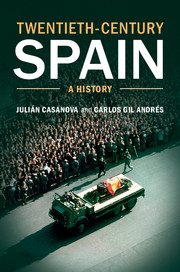Book contents
- Frontmatter
- Contents
- List of illustrations
- Key figures
- List of abbreviations
- Twentieth-century Spain timeline
- Maps
- Introduction
- Part I The monarchy of Alfonso XIII
- Part II The Second Republic
- Part III The Civil War
- Part IV Franco’s dictatorship
- Part V Transition and democracy
- 13 The Transition
- 14 Democracy
- Conclusion: the balance sheet of a century
- Guide to further reading
- Index of names and authors
- References
14 - Democracy
Published online by Cambridge University Press: 05 July 2014
- Frontmatter
- Contents
- List of illustrations
- Key figures
- List of abbreviations
- Twentieth-century Spain timeline
- Maps
- Introduction
- Part I The monarchy of Alfonso XIII
- Part II The Second Republic
- Part III The Civil War
- Part IV Franco’s dictatorship
- Part V Transition and democracy
- 13 The Transition
- 14 Democracy
- Conclusion: the balance sheet of a century
- Guide to further reading
- Index of names and authors
- References
Summary
The PSOE’s spectacular victory in the 1982 general election, with an unusually high turnout, enhanced the process of democratic consolidation. The exceptional result enabled Felipe González to head a strong government to tackle pending military, economic and social reforms. The socialists were in power for almost fourteen years, a long period of political primacy during which the pattern for regional self-government was developed, the welfare state was enlarged and Spain was integrated into European institutions. But they were also years of illegal activities in the fight against terrorism, corruption scandals, labour protests and an economic crisis that began in 1992, which had a severe effect on the Spanish economy leading to an exceptionally high unemployment rate.
By the time the twentieth century ended, Felipe González was no longer in power, nor even the leader of the PSOE, with the party steeped in a crisis from which it would take a long time to emerge. The 1996 election was won by the Partido Popular, under José María Aznar. Its first term was marked by spectacular economic growth and a moderate ideology that changed in 2000, when it won an absolute majority and implemented a right-wing neo-conservative programme that was dominated by a political confrontation strategy that was far removed from the climate of consensus during the Transition.
- Type
- Chapter
- Information
- Twentieth-Century SpainA History, pp. 328 - 354Publisher: Cambridge University PressPrint publication year: 2014



